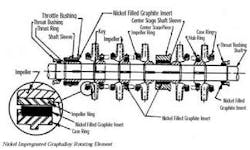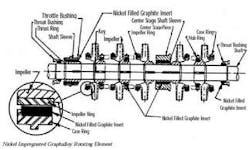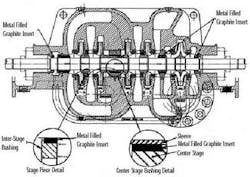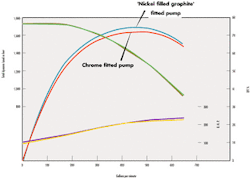Improving Pump Reliability with Metal Filled Graphite Wear Parts
By Robert P. Komin
In the past 15 years the use of self-lubricating bushings and case rings in single and multistage horizontal boiler feedwater pumps has moved from a curiosity to an accepted standard. The change was driven by operational practices that have placed severe demands on the traditional horizontal multistage pump. These practices have resulted in increased failure rates, with more down time and higher maintenance costs for the pump user. Typical problems have been dry running with subsequent galling of wear surfaces and pumps subjected to rapid temperature transients resulting in fractures or galling and seizure.
A multistage horizontal pump requires a flow of pumpage through the bushing and case ring annulus to both support and center the rotating element. If this flow is interrupted due to insufficient NPSH, the pumpage flashing or a system upset, the rotating element will sag due to its weight and may contact the stationary members.
When the stationary members are of similar material, such as the standard combination of chrome impeller and case rings, these members will gall (weld) when they touch. In general, when identical metals make contact while running dry, galling will take place at a series of isolated points. After sufficient force is developed by the rotating member, the welds are torn loose, leaving a rough surface at which welding is almost immediately repeated until the rotating member can no longer tear itself loose and seizure occurs.
Background
Metal filled graphite is the standard bushing material for vertical pumps in heater drain, hot well and condensate service. It is used because of its unique properties of self-lubrication, chemical resistance, dimensional stability, resistance to high differential pressure erosion and high load carrying capacity.
Initially, using metal filled graphite as bushings and case rings raised concerns whether the material could withstand the rigorous conditions, such as high peripheral velocities and differential pressures, found in a multistage horizontal pump.
After more than 15 years of field experience, in a multitude of installations, neither of the factors has been a problem. Initially, abrasives in the pumpage were a concern but new grades of metal filled graphite have been used successfully in boiler feed systems subject to occasional abrasive upsets.
Running clearances are often dictated by the requirement to prevent contact of the rotating and stationary member. Large running clearances penalize hydraulic efficiency by allowing excessive stage to stage internal leakage. Since metal filled graphite is a self-lubricating material, running clearances can be significantly reduced, thereby improving pump hydraulic efficiency and rotor dynamic stability without the risk of rotating element seizure.
Material Description
Metal filled graphite is not a single material, but rather a family of materials, each of which can be varied within wide limits to suit a specific application. Hundreds of grades are produced for a multitude of pump applications, ranging from cryogenic to extreme high temperature.
Metal filled graphite is made by compounding carbon fillers, binders and additives. These raw materials are converted into a plastic dough in a heated mixer. The dough is cooled, crushed and ground into powder. The powder is blended with an organic binder and formed into a rough shape. Placed in a controlled time, temperature and atmosphere oven to convert the organic binders to carbon and then baked to produce a porous fine-grain graphitizied material. The piece is slowly cooled and then rough machined to as close to the finished shape as possible. The porous semifinished piece is reheated and impregnated, by a pressure or vacuum process, with molten metal, cooled to room temperature, then machined or ground to finished size and tolerance. The metal used to impregnate the graphite is selected to be compatible with both the environment and application.
OEM Test Program
After a number of successful field conversations, a Pump OEM decided to run a test program to document the improvement in reliability and hydraulic performance of a metal filled graphite fitted multistage horizontal pump.
The test program had three objectives:
- Obtain adequate test data to validate any hydraulic efficiency improvement with the closer running clearances possible with the non-galling metal filled graphite fitted pump.
- Verify the ability of a metal filled graphite fitted pump to survive a Dry Run (loss of suction) and remain operable.
- Verify the capability of a metal filled graphite fitted pump to operate for extended periods of time at shut off (closed discharge valve) and remain operable.
Test Pump
The test pump was a five stage, axially split, single case, opposed impeller, double volute, with a single suction first stage impeller. Nickel Impregnated Graphalloy was selected for the case rings and bushings based upon the temperatures anticipated during the dry run and shut-off portions of the test program.
Test Results
Tests 1 and 2 were identical six point base line performance tests, performed to show the improvement in hydraulic efficiency. For Test 1, the pump was fitted with "chrome on chrome" wear parts with industry standard running clearances. Test 2, used Nickel Impregnated Graphalloy stationary and chrome rotating parts with a reduced running clearance for a comparison of running clearances.
At the BEP (Best Efficiency Point) the Nickel Impregnated Graphalloy fitted pump had a 2% higher efficiency than the "chrome on chrome" fitted pump.
Dry Run Test
A dry run test was conducted to see how a Nickel Impregnated Graphalloy fitted pump would perform under a loss of suction. A data point was taken to verify the pump performance was identical to the base line performance test. The pump was then run dry by closing the suction valve and opening the discharge (outflow) valve. Mechanical seal injection was maintained at the rate of .25 gpm. The dry run continued for 22 minutes and was concluded when no visible changes were observed and all temperatures had stabilized. The suction valve was opened and the test loop refilled. A six point base line performance test was immediately run which confirmed the 22 minute dry run had not changed the pump hydraulic performance. Post test inspection reveled no rubs, unusual wear or other anomalies.
The same basic test was conducted with a chrome fitted pump. A data point was taken to verify the pump performance was identical to the base line performance test. The suction valve was then closed. The motor wattage dropped from 492 to 25 and remained steady. After two minutes, the wattage then jumped to 500 watts in five seconds and the pump was immediately shut down. The rotating element came to an abrupt stop, it had seized.
Post test inspection revealed galling (welded together) of the first stage eye side case and impeller wear ring. Galling also occurred between the throttle bushing and sleeve at the other end of the rotating element.
Shutoff Head Test
Another test examined the performance of the Nickel Impregnated Graphalloy fitted pump when the discharge pump was closed. The pump was run at shutoff condition (no flow) for 54 minutes. The pump internal temperature was recorded at the fifth stage volute, it stabilized at 315 deg F after 45 minutes.
After 54 minutes of running at shut off, the leakage from the mechanical seals began to increase, so the discharge valve was quickly opened. Opening the discharge valve resulted in a temperature transient with a cooling rate change of 22 deg F per second.
After the pumpage temperature had stabilized, A six point base line performance test was immediately run which confirmed the 54 minute shutoff test and the subsequent thermal shock caused when the discharge valve was opened had not changed the pump hydraulic performance.
Post test inspection reveled no rubs, unusual wear or other anomalies.
Abrasive Wear
A major concern regarding metal filled graphite in boiler feedwater systems is its ability to withstand abrasives sent through the pump, the result of an occasional system upset. In the past five years, a "condensate pump" grade of Graphalloy has been developed that has more than double the operational life of either bronze or plain carbon wear members.
In order to get a comparison of the abrasive wear characteristics of the condensate pump grade Graphalloy, an ASME Wear Test was preformed at Reneeslaer Polytechnic Institute in Troy, NY.
The results of the Abrasive Wear Test Program showed that the condensate pump grade Graphalloy was approximately 2.8 times better than plain carbon and approximately 2.5 times better than SAE 660 bronze in resisting abrasive wear.
Field Experience
Oil Refinery Boiler Feedwater Pumps — There are four Ingersoll Rand 6 stage "CNTA" radial split horizontal pumps in this boiler section. Many of the operating units that use this boiler section are driven by steam turbines. Problems occur when the feed stock changes and the rate is quickly increased or decreased. The demand on the steam turbines causes the boiler feed pumps to operate anywhere from shutoff to maximum flow. As the demand for steam increases or decreases, a signal is given to one of the stand-by pumps to start up or for an operating pump to shut down. When an operating pump shuts down, it can momentarily run dry which may cause it to seize.
The condensate pump grade of Graphalloy was installed in one pump in July 2001. The second pump was converted in August 2001. Both converted pumps have survived the last dry run that caused the third metal fitted pump to fail. It is now being converted to the condensate pump grade of Graphalloy stationary wear parts. The fourth pump will be converted when it seizes.
Paper Mill Boiler Feed Pump — In August 1986, a four stage radial split Worthington "UNQ" boiler feed pump was retrofitted with Graphalloy stationary wear parts. The pump was converted because of repeated seizures while fitted with standard "chrome on chrome" wear parts. The pump operated without incident until it was pulled for routine maintenance in March 1991. At that time, the spare pump was also retrofitted with Graphalloy stationary wear parts.
The sister paper mill located about 50 miles away, seized its boiler feed pump over the Labor Day holiday and arranged to borrow the spare boiler feed pump from the other mill. After installing the borrowed Graphalloy Fitted Pump, it was coupled to the steam turbine and brought up to the operating speed of 3700 rpm. Staff soon discovered that the Graphalloy fitted pump, which had closer diametrical running clearances, was producing too much capacity. In order to reduce the pump capacity, it was necessary to slow the turbine down to 3250 rpm.
When you change the speed of a pump, here's what happens:
- The pump capacity varies directly as the change in speed
- The head (pressure) varies as the square of the change in speed
- The power required varies as the cube of the change in speed
In this case, when the pump was slowed from 3700 to 3250 rpm, theoretically, the power required to required to run this pump changed as follows, ([3250/3700]3) = .678. That is to say, equipped with Graphalloy wear parts, it will require only two-thirds as much power to operate the pump at 3250 rpm as it did at 3700 rpm.
Conclusion
The test programs and field experience demonstrate the ability of a pump equipped with metal filled graphite wear parts to survive a loss of suction or running at shutoff for extended periods without seizure. Metal filled graphite does not melt, distort, unravel or fall apart when used at temperatures as high as 750 deg. F. So it is not necessary to replace the metal filled graphite wear parts should the pump be operated at those conditions. The use of closer running clearances possible with metal filled graphite also provides better damping of the rotating element thereby reducing vibration and increasing both the mechanical seal and thrust bearing service life.
About the Author: Robert P. Komin has represented Graphite Metallizing Corp. since 1981. He is the West Coast Engineering Sales Representative for Graphalloy Products. Prior to joining Graphite Metallizing, Komin was an Assistant Chief Engineer with Sulzer Bingham Pumps Inc. in Portland, OR. He was previously employed by Johnston Pump, Peerless Pump and J.C. Carter Pump companies. He has spent over 30 years working directly in the pump industry.



